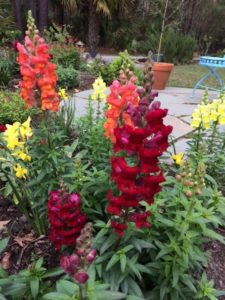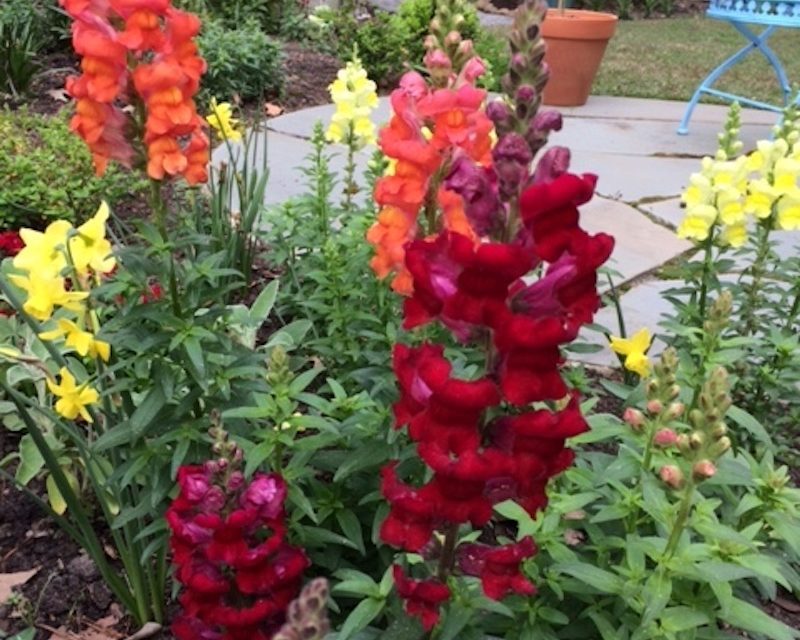
Snapdragons
I have always wondered why Europeans and Brits seem to be so obsessed with some of our native plants like Golden Rod (Solidago) and Asters (Symphylotrichum). It turns out that most native European and British flowers and quite a few of their imports from Asia are spring and early summer bloomers. That would leave their gardens looking rather bleak by August. We are so fortunate to have late summer and fall bloomers. And we also have fall color, even in the Lowcountry.
In the 1700s a Quaker by the name of John Bartram made quite a business of shipping plants from North America to England in what became known as Bartram’s Boxes. The Brits could not get enough of the goodies that Bartram shipped from Philadelphia to London. What were in the boxes? Interestingly enough, his most popular item was Liquidambar styraciflua. When I looked it up and found out that it was Sweetgum, I was more than slightly horrified. I hate that tree and its seedpods that look like the Corona Virus. But it does have fall color. Also in the boxes were maple trees (Acer) and Sumac (Rhus). Anything that had color in the autumn was coveted. It was a sign of status among wealthy British aristocrats to have what they called their “American Garden” with imports from abroad. Sumac is still used in garden design today in Britain as a treasured shrub. America is blessed with fall colors and fall flowers that are desirable to the rest of the world.
In my garden, I have a late flowering salvia, Salvia madrensis, that is quite tall and has long forsythia like yellow flowers that last into January or later. Another late bloomer is Hamelia patens or firebush with a profusion of yellow and orange flowers. It can be affected by a hard freeze, but mine have come back. Deer do love it, so beware. Salvia madrensis is left alone by the four hooved marauders.
I also love the Cupheas and they are late bloomers. They have many common names – e.g. Mexican cigarette plant, firecracker bush. One winter, mine bloomed all winter long without stop. It can die for no apparent reason, but replacements are easily found at local nurseries. It is another one on Bambi’s Buffet, but you can grow it in a container and place it out of harm’s way. All of these plants that I have named like full sun.
Marigolds (Tagetes spp.) are wonderful late summer through the fall bloomers. There are many varieties in nurseries. One to watch for is Mexican Mint Marigold (Tagets lucida) which as Sandra Educate has noted, is a great replacement herb for tarragon. Mexican Marigold can grow into a shrub with feathery leaves and abundant yellow flowers. All Marigolds are good as companion plants because they keep away insect pests and deer do not like their strong smell. Marigolds are native to the American southwest and Central and South America. The flower was associated with legends in prehistoric Mexico and is still used in Day of the Dead celebrations. Marigolds are considered to be annuals, but they can winter over here or spread by seeds for new plants each year.
Another annual that can be perennial is the Snapdragon (Antirrhinum spp.) I love to have winter color in my garden so I buy snapdragons in the fall as soon as I see them and mine last all winter. I usually find that by August, my snapdragons are weary looking and I pull them out and plant new ones. They are not expensive so I allow myself this luxury,
Geraniums (Pelargoniums) also bloom all winter long. They die back in the heat of the summer, but when autumn comes, they come alive. Geraniums are easily propagated by taking cutting of the stems. You can then root them either in water or a seed starting soil mixture. I have several Geraniums that I have had for years and I keep on making new offspring from their cuttings.
One of my favorite colors of the late fall is Cassia. There are many varieties, but the most common variety down here can grow into a small tree. In the late autumn, they have hundreds of bright yellow flowers attracting bees and other pollinators. They do tend to lose some or all of their leaves in the winter, but they are worth having for that wonderful burst of sunshine yellow.
And our biggest autumn treat in the Lowcountry? Camellia sansanqua! This Camellia has smaller leaves than its brother, Camellia Japonica, and blooms in the late fall to early winter. There are so many different types and colors – some with double blossoms, some with single, and bright pink, white, or red colors. My favorite is a variety called “Yuletide” with red blossoms and bright yellow centers.
It is a smashing addition to a holiday yard and takes no electricity to work its magic.
And what about Chrysanthemums, I hear you say. I think that they are the essence of fall and I remember fondly getting a Homecoming corsage of a giant football mum at my high school outside of Cleveland. Unfortunately, they do not grow that well down here. I have planted them in the ground from containers after they have gone by and they do come up again. The problem is that they bloom at peculiar times of the year and do not really flourish. I buy them every year for my front porch, but then compost them. You might have better luck than I do. Mums like well-drained soil and mine is definitely not so that may be the issue peculiar to my garden.
Even though our sticky weather does not feel like fall yet, cooler temps are on the way. Our lovely late blooming flowers will keep our gardens looking interesting into the winter.











